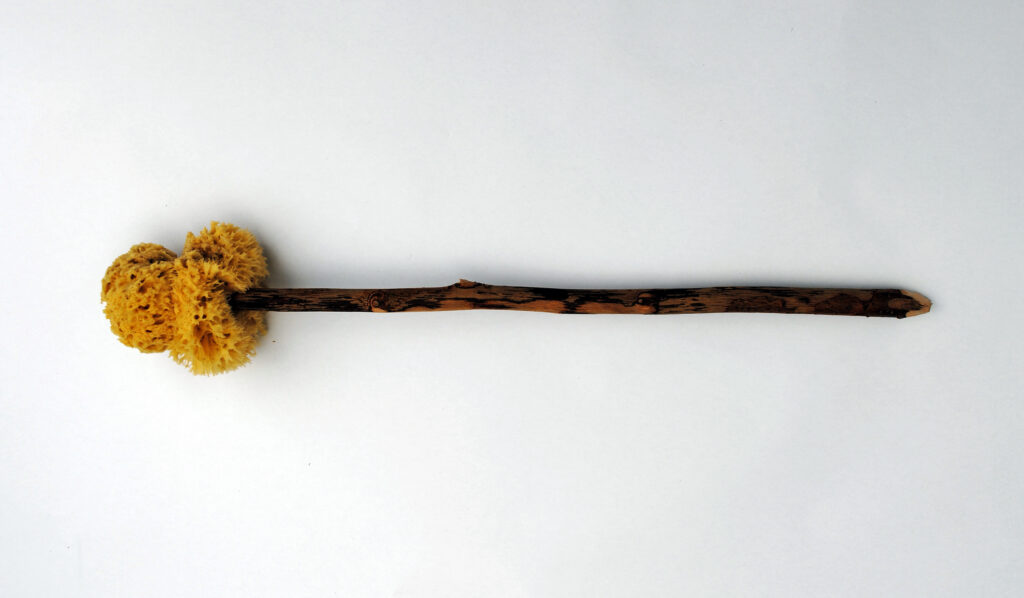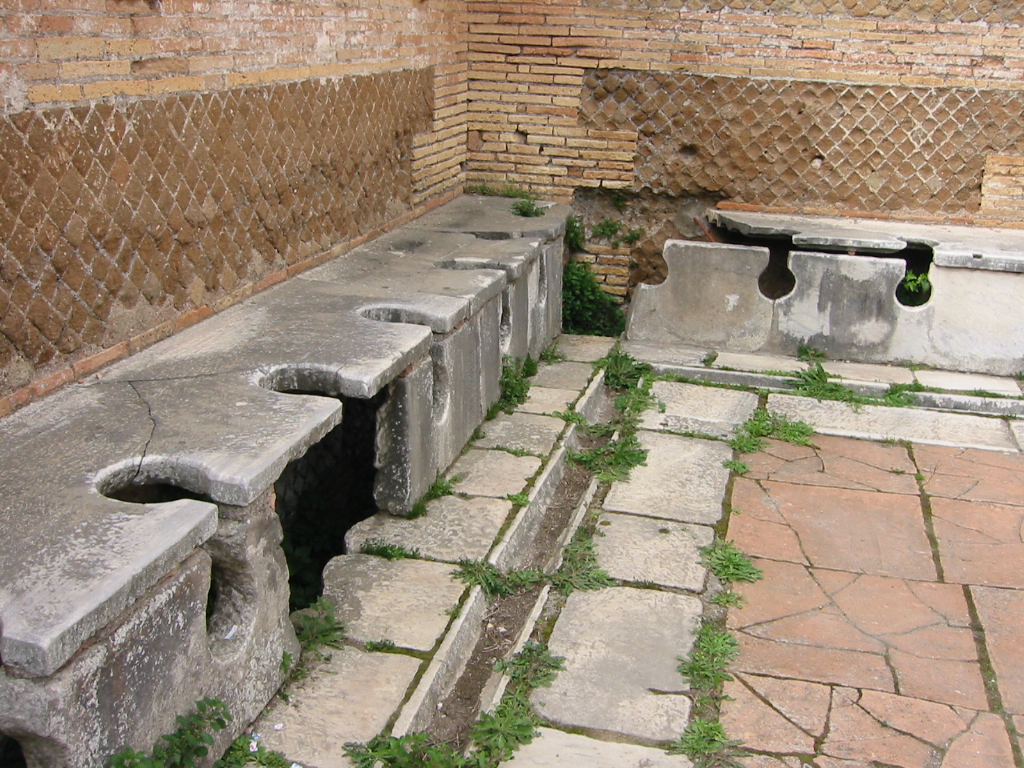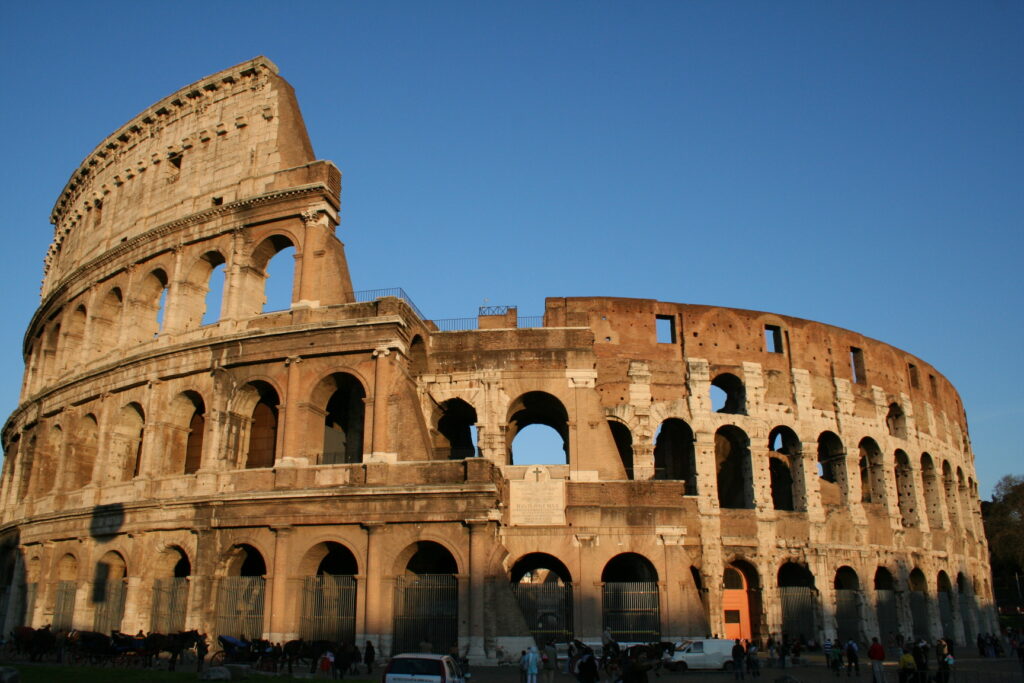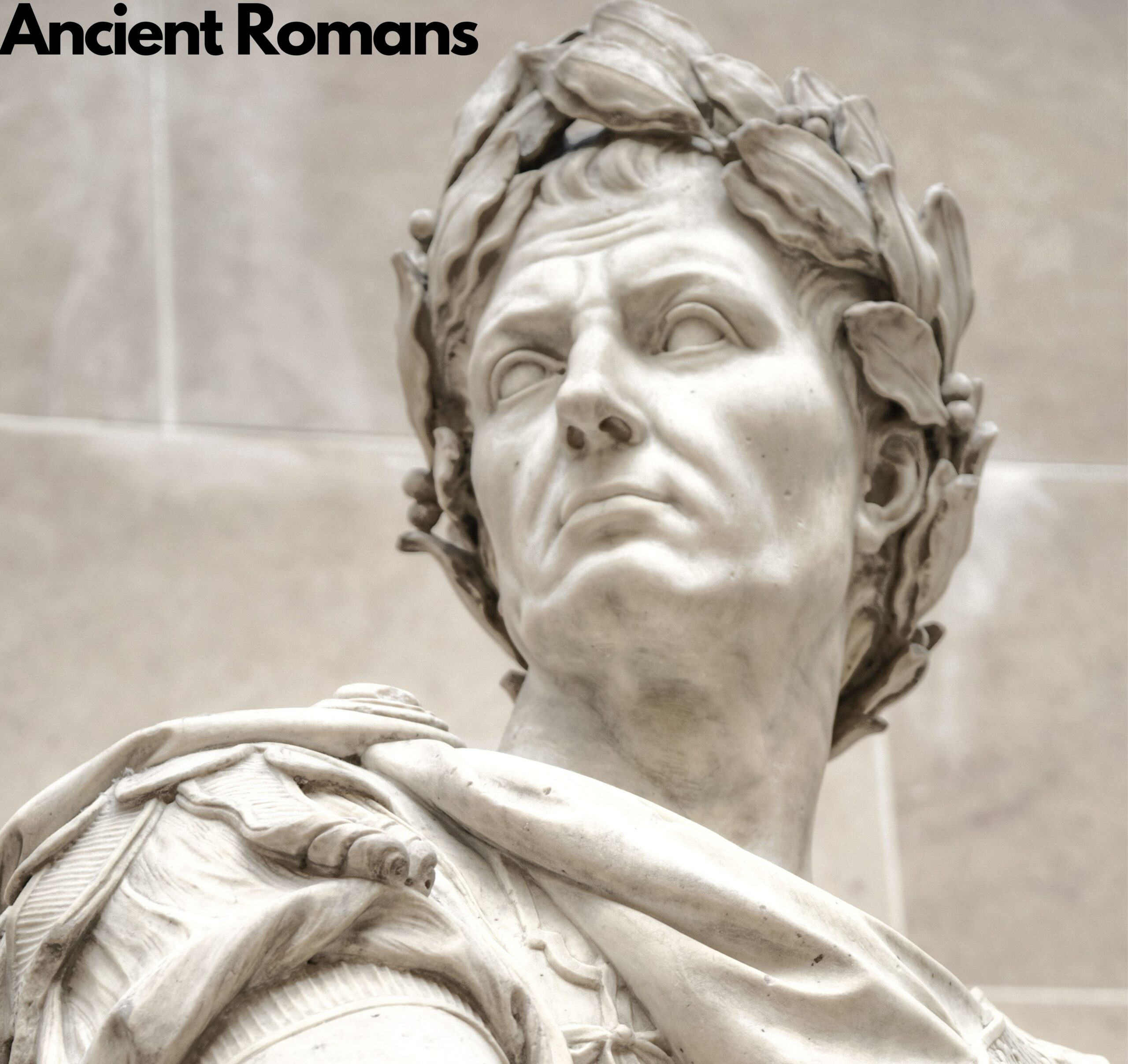Hello and welcome to another not-so-romantic blog written by me. Andy Lickley. Today I’m talking about one of my passions. The Ancient Romans.
The Ancient Romans have a long history and I’m attempting to unlock their fascinating civilisation.
Table of Contents
The Rise of the Roman Empire
When you think of the Ancient Romans I think most people think only about the huge empire but before the empire, Ancient Rome was a republic. The Roman Republic was founded in 509 B.C.E. and remained in place until 27 B.C.E. when a certain Julius Caesar was assassinated by Senators and Augustus reorganised the Republic into an Empire… sounds a little bit like Star Wars now I think of it.
At any rate, Caesar thought the republic was old-fashioned so after crushing a civil war he declared himself dictator of the Romans. His rule lasted less than a year before he was assassinated- but the groundwork had been laid and the Roman Empire had begun.
Roman society and daily life
Life for Ancient Romans was a mixed bag. If you were rich you would have a comfortable and more than likely enjoyable life. As a member of a wealthy family, you would start school at 7 years old, learning to read, write, maths and even the art of debating. If you were amongst the wealthiest family you would be tutored full time at home.
Educated citizens could expect to get jobs like an engineer, lawyers or a teacher.
They didn’t lack food, had lots of jewels and bling and had nice houses.
The Poor
If you were poor, life would have a slightly different picture…
In Rome itself, the poor lived in the smelliest, noisiest and dirtiest part of the city. This isn’t unique to Ancient Rome or even the ancient world. The houses were poorly constructed and really crammed together to squash as many people in as possible. The term for this is “the slums”.
Jobs for the poor included farming, merchant, craftsman and entertainers. They mostly would only be able to get unskilled jobs as poor people didn’t get to go to school.
It wasn’t all bad though. Everyone could get into the Colosseum for free so at least the entertainment was free.
But the question we’re all asking is. What did the Ancient Romans eat?
Food
Most Romans would eat a small breakfast and then very little else until dinner at around 3 pm, where they would eat a lot. What’s cool is they would mostly eat with their hands which massively saves on washing up.
They ate bread, beans, fish, vegetables, cheese and dried fruit. Some of the richer citizens would eat peacocks and mice tongues… gross.
Clothes
In terms of clothes, citizens would wear tunics or togas- I always imagine them looking a little bit like Jedi. They did often have woollen cloaks, just like Jedi. Ancient Romans were Jedi confirmed?
Jedi… sorry I mean Ancient Romans didn’t wear trousers unless it was required for military uniform. Trousers were actually associated with Barbarians so if you wanted to show how Roman you were you wouldn’t wear them.
Women would also wear tunics and togas but they would be longer than the males in order to cover over their ankles. Over the top would be a Stolla which was basically a long dress.
I’m gutted to have to tell you that there isn’t much known about what the Romans wore as underpants.
But we do know that when it came to cleaning clothes Romans used pee. So if you were working in a laundry. You’d put the dirty clothes in a big wooden bucket, drench them in wee then squish it all together by standing in it… barefoot.
These are people who used crushed mice brains as toothpaste so standing in wee isn’t even that disgusting compared to that.
Toilets
When we go to the toilet in our houses we don’t tend to let anyone else in the room, let alone let someone sit next to us. The Ancient Romans had no such reservations. In fact, if they went to a public bathroom they’d be sat in a room full of toilets with everyone going about their… well… business.
These toilets didn’t flush, at best they would have a slow trickle of water constantly flowing underneath them. I’ll emphasise the slow trickle of water again. If you had a particularly meaty meal the day before that poop wouldn’t be going anywhere. I kind of wish I wasn’t eating when I wrote that.
Just like everyone else does nowadays, Ancient Rome citizens would have sat down upon the toilet- which at this point were either long wooden boxes with holes cut in or long stone boxes with holes cut in them to deposit the poo- and if it wasn’t particularly big or heavy they could watch it being pulled away into the sewers.
Now when you’ve done a poo you, hopefully, reach for the toilet paper. Not Ancient Romans though. Instead of toilet paper, they reached for a tersorium. To put it a different way, a tersorium was a toilet brush for your bottom.

If you’re not sure what a toilet brush looks like because you never clean a bathroom then imagine a glockenspiel or xylophone mallet with a flannel wrapped around the top. You could even make your own at home- useful for travelling I hear.
You’d use it to wipe your bottom, clean it as best you could in the trickle of water or a bucket then leave it for the next people to use. Sharing is caring.

If you wondering what Romans did when they needed a wee at home. They would probably do it in their equivalent of chamber pots and then throw it out into the street.
The Emperors
The Ancient Roman Empire was ruled over by a long list of emperors. In total, there were around 70 different emperors. It started with Augustus in 27 B.C.E. (before the common era) and ended with Romulus Augustus in 476 C.E. (common era).
With over 70 to talk about it wasn’t easy to narrow down the ones to mention in this blog. I don’t have a word count large enough to write about every single one. I’ll do some future deep dives on some of the emperors but for now, here are two to get us started.
Augustus
Augustus was the first emperor of Rome. He was born Gaius Octavius in 63 B.C.E. Julius Caesar was his great uncle. He impressed his great-uncle in battle and was named his political heir alongside inheriting Caesar’s fortune.
Augustus is definitely a whole blog all by himself. In fairness, he’s probably worthy of an entire book. He was the one who started the Roman Empire by pulling together strong political forces. Augustus was smart, fierce and determined.
It’s not always documented but I have no doubt some shady stuff was done to gain and keep hold of power. It can’t have been easy to end all of the civil wars ripping through the former Roman Republic.
He reorganised life under his rule, passed laws to help with stability, expanded the Roman road system, added a police force in Rome and something not often spoken about he introduced a postal service- he was clearly a fan of writing postcards.
Under his reign he took control of Egypt, part of Spain a lot of central Europe and some parts of the Middle East.
Nero
I thought I’d give Nero a quick shoutout though I’m not honestly sure where to start. As emperors of Ancient Rome go, Nero is one of the better known. Despite his interesting… erm… yeah I’ll stick with interesting- story, I definitely wouldn’t have wanted to meet him.
He became emperor at the age of 17, though there is a larger than large chance that it was his mother who had poisoned Claudius who had come before him. Word of advice, avoid mushrooms if someone out for power offers them to you. I love mushrooms so I doubt I’d be able to resist.
Nero’s step-brother – his biggest threat to power- died only a day before he was about to turn old enough to make a challenge for the throne. Suspicious. You had to be at least 14 to be eligible for ruling.
Nero’s mother, Agrippina, had such a tight hold on her son and power that she appeared on Ancient Roman coins alongside Nero in his early reign. Nobody likes their mum hovering over them but where most people politely ask their mothers to back off- Nero killed his.
He also murdered two of his wives.
He was accused of planning the great fire of Rome in 64 C.E. To throw the Ancient Romans off his trial he blamed the Christians. He did build a huge golden palace in the space that the fire had freed up, so I’ll leave it to you to decide whether he is innocent or guilty.
Nero was definitely one of the more interesting emperors to have ruled over the Ancient Romans.
If you want more information on some of the Roman Emperors, check out this other not-so-romantic blog.
Gladiators and Spectacles: The Roman Entertainment
Colosseum
If you were to visit Rome today one of the most inspiring sites is that of the Colosseum (or at least what remains of it). The Colosseum started construction in 72 C.E. before being completed in 80 C.E. and was the home of Roman entertainment. In fact, it wasn’t uncommon for some contests to last for 100 days.
Originally the Colosseum was coated in marble, but that was gradually removed and reused elsewhere- though some marble does remain on the upper tier and was originally fitted with a retractable roof.
The huge arena could hold up to 80,000 spectators which is the same as Twickenham Stadium in London where England Rugby Union play their home games. The Colosseum is the largest amphitheatre ever built but hasn’t always been called the Colosseum, it was first called the Flavian Amphitheater, named after the Flavian Dynasty of emperors who built it.
The Flavian Dynasty consisted of Vespasian, Titus and Domitian. Not quite as cool as the three musketeers, but then again- who is?
The Colosseum was built on top of an artificial lake which had been part of Nero’s golden palace. They drained it to make way for the Colosseum and has actually been damaged by several natural disasters like Earthquakes and some less natural disasters in the form of at least 3 great fires.
For the main part, the main entertainment in the Colosseum walls was fighting between gladiators and the killing and fighting of animals. The last gladiator fights were held in 435 C.E. and the last animal hunts were in 532 C.E. Games also included naval battles. They actually flooded the arena and ship battles took place inside.
The Colosseum was used for well over 500 years and since the fall of the Roman Empire, it has been used as a graveyard and a fortress. Nowadays it is a UNESCO World Heritage Site which means it is protected from being destroyed.

Circus Maximus
If the entertainment of the Colosseum wasn’t enough Rome also had the Circus Maximus which was a chariot-racing stadium. It’s pretty sizable being six hundred and twenty-one meters long and hundred and eighteen meters wide. I think the phase I’m looking for is “difficult to miss”.
It was built in the late 7th century B.C.E and became the largest stadium in the entire Roman Empire- once the Empire had been formed of course. It wasn’t uncommon for the site to be flooded until Emperor Claudius had some structural work done and an anti-flooding embankment was added.
Trajan had the Circus Maximus rebuilt out of stone to stop it from being damaged by fire. I’m honestly surprised it took so long for them to figure out they shouldn’t build their important buildings solely out of wood.

The Roman Gods and religion
The Ancient Kingdoms seemed to be crammed full of Gods and Goddesses and the Ancient Romans were no different. In total there was something in the region of 67 Gods and Goddesses- luckily for those like me with a bad memory, there were only 12 main Roman Gods.
1- Jupiter- King of the Gods
2-Juno- Queen of the Gods
3-Minerva- Goddess of wisdom, arts, trade and strategy
4-Neptune- God of the sea
5-Venus- Mother of the Roman people- would not have wanted to pay that childcare bill
6-Mars- God of war
7-Apollo- God of music
8-Diana- Goddess of lower classes and twin of Apollo
9-Vulcan- God of fire
10-Vesta- Goddess of home
11-Mercury-God of profit and trade
12-Ceres- The eternal mother, Goddess of agriculture, women, marriage and motherhood.
If you think the God and Goddess roles sound similar to some of the Ancient Greek Gods and Goddess… then you’d be right. They’re basically the same Gods and Goddesses with different names given to them by the Ancient Romans.
Roman achievements and contributions
Roads
I feel like we all take roads for granted nowadays and don’t always appreciate just how important they are. Roads allow people to travel to the shops, hospitals and – perhaps sadly- work.
Roads in Roman times were helpful for transporting the army and improving trade throughout the Empire. If you’ve ever played Rome Total War then upgrading your road system is an absolute must.
The Romans loved roads so much that they had around 370 paved highways across the Empire by 300 C.E. to further signal their importance to the empire.
Aqueducts
One of the best Roman achievements was the aqueducts.
Aquaducts allow fresh spring water (thanks to gravity) to be transported to cities. Without water, people will go thirsty and thirsty people don’t conquer half the known world.
Aqueducts are made of stone and could transport thousands of gallons of water every single day, which is a good thing as at the height of Ancient Rome around 38 million gallons of water was used every day for the 1200 fountains, 11 great and 86 other baths and 2 artificial lakes. That’s probably the reason Rome itself had 11 aqueducts supplying it with water.
1. Aqua Appia
2. Anio Vetus
3. Aqua Marcia
4. Aqua Tepula
5. Aqua Iulia
6. Aqua Virgo
7. Aqua Alsietina
8. Aqua Claudia
9. Anio Novus
10. Aqua Traiana
11. Aqua Alexandrina
(Just in case you were interested)
The Ancient Romans built over 200 aqueducts in Italy, France, Spain, the Middle East, Turkey and Africa.
The Fall of Ancient Rome
All good things must come to an end – not sure I entirely agree with that statement- but the Ancient Roman Empire eventually come to an end. It didn’t happen overnight though as the Empire had been crumbling for years beforehand.
It’s a whole not-so-romantic blog in itself about why the Roman Empire fell, but if you wanted some quick reasons then being invaded by the blasted barbarians- the Visigoths actually sacked Rome. – I don’t mean like fired them from a job, I mean wrecked it.
Money dried up, bad emperors with no leadership skills and honestly getting too big. It expanded quickly and couldn’t keep up. Splitting itself in half to be the Western and Eastern Roman Empires in the late 3rd century C.E. wasn’t the most sensible thing to do either.
They also couldn’t hire enough soldiers so they couldn’t ward off everyone who came for their heads.
What to read next
Thank you for reading this not-so-romantic blog, I hope you enjoyed reading it as much as I enjoyed researching and writing it. If you are in the mood for blogs about the Ancient Romans then here are some I recommend you read next.
- Five Roman Emperors you should know about
- The Story of Pompeii
- 10 facts you didn’t know about the Romans
If you fancied some Ancient Egyptians reading then be sure to check that out here.
You’ll have noticed in this blog about Ancient Romans I didn’t even mention any battles… fear not! If you like battles then make sure you keep checking back to the not-so-romantic blog because something epic is coming soon.
Thanks once again for reading! Be sure to let me know your favourite thing about the Ancient Romans below!
